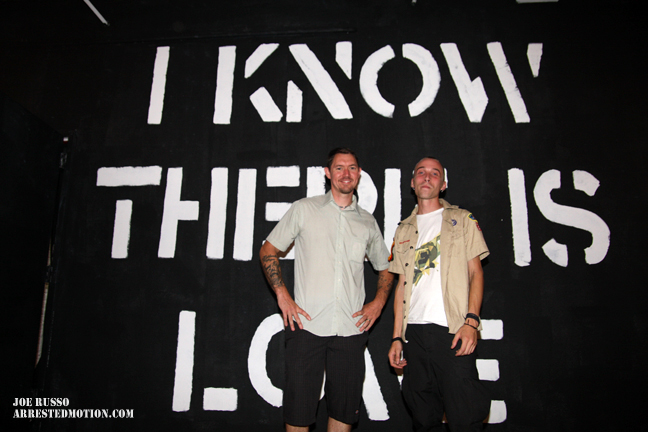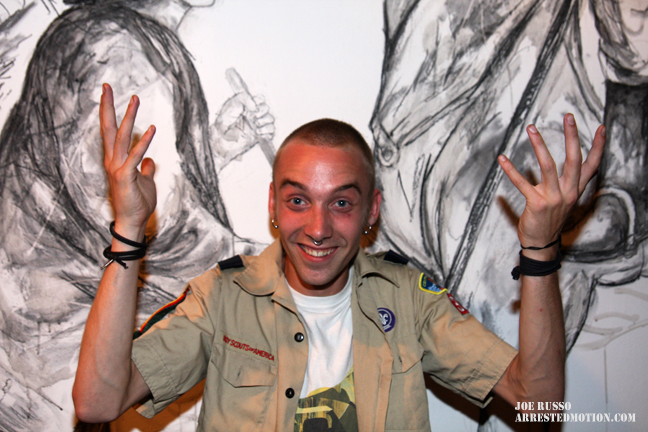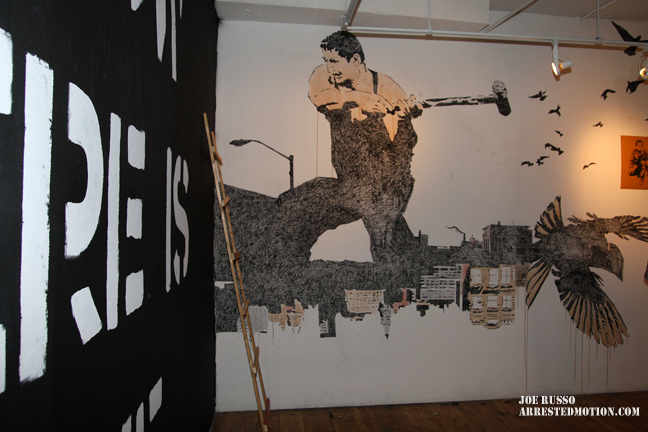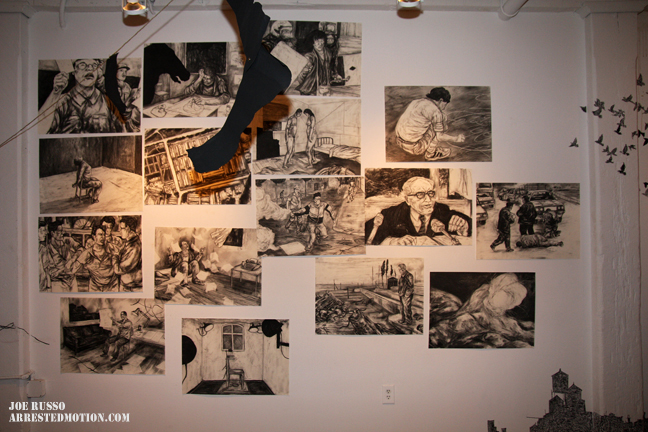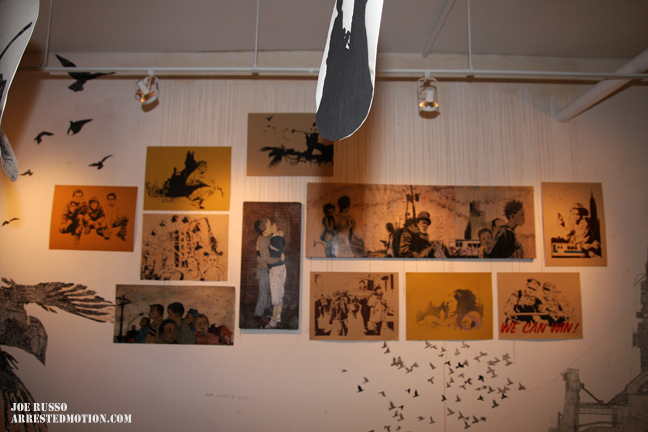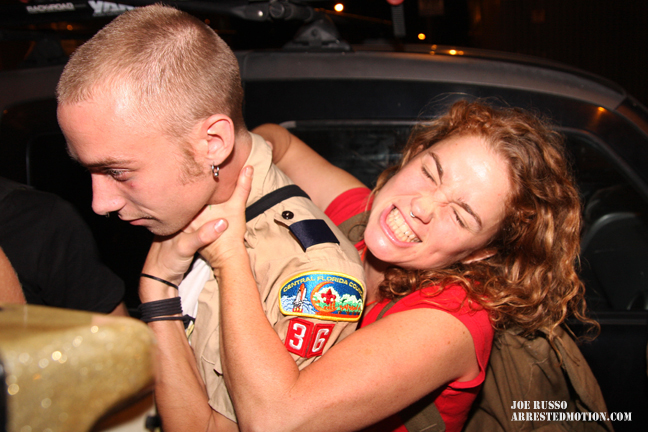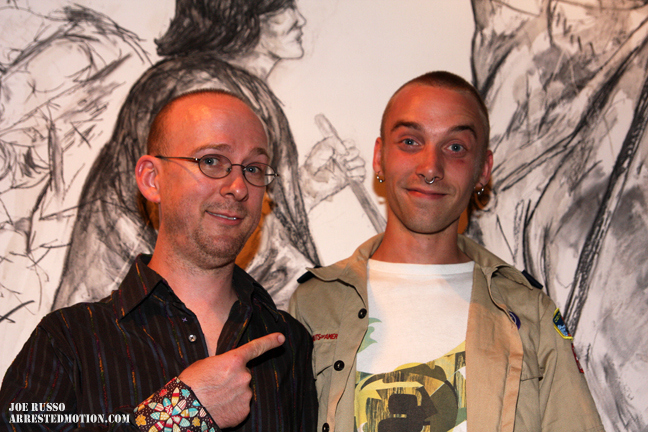Last Friday, Chris Stain and Armsrock opened their two-person solo show “I Know There Is Love” at Ad Hoc Art. Their unique individual explorations of the hope and dignity found in everyday urban life while still maintaining the undertones of its challenges and despair paired together very nicely. AM had a chance to interview with both Chris and Armsrock, in which they talk about how their individual bodies of work interact with one another, the inspiration for the show and more.
Read the full interview and take a look at all the photos from the opening after the jump…
Arrested Motion (AM): How did this show come about?
Armsrock (AR): Ad Hoc had been communication simultaneously with Chris and me about doing something, and we had been working together in London a year ago and both knew that we wanted to try to do that again. We have a very straight forward way of communicating about things, a directness of language, and even though Chris is a fair deal older than me, we have strikingly similar backgrounds, we went through the same motions in different places and times.
Chris Stain (CS): Way back in February I was asked to do a show sometime this year at Ad Hoc. The gallery made a few suggestions of people to pair up with. I suggested Armsrock because we had worked together once before in a 3 person show in London curated by Swoon. We hit off but I felt like maybe we didn’t have a chance to explore our potential for working together. As we have similar themes to our work it made sense to me to give it another shot.
AM: There are some obvious clues in the title of the show but can you tell us more about the particular issues and themes your hoping to explore and communicate in this body of work?
AR: The process of getting here wasn’t an easy one. I have for the last long time been trying to involve myself in work that are dealing with the darker currents in the human society. I found that my focus were tending to lock itself on drawing attention to things I think of as wrong and to denounce them through my work. When Chris and me were first starting to discuss what this show should be about, I wanted to do something about the origins and history of racism, which is something I thought could be interesting doing in this country at this point in time. And we had actually started to have a discourse about it, when Chris wrote me a longer email wishing to change the theme of the show, and of all things to make it about “love.” I don’t have the email with me here now, but I remember that it was a very solid argumentation, reminding me that it is important not only to denounce that which brings pain and sadness, but also to lead attention to that which inspires and brings hope. Chris send me this text of a song by the band Crass, which I hadn’t by then heard in quite some time, but which when I first heard it, inspired me immensely. The song is a long rant about all that feels wrong and all that spreads repression and hurt, but it ends with the sentence “you have given me hate when I know there is love.” And that sentence hit a vulnerable point with me exactly at that moment in time. So I started on this series of work that was to be a discussion with myself about my relation to hope, and “hope despite of”. Putting this work in the gallery seems a little like showing other people my sketchbook, the unfiltered and often blunt thought process. And now as I am sitting in the finished exhibition writing this, the whole thing seems very much like a sketchbook. It is as if we asked ourselves and each other some questions that we could not really answer, but we circled the questions and gave them form, found their edges and opposites, drew these onto the walls and turned it all into something tangible that we could share with others. The entire process of this show has been carried by a feeling of attempting to “think out loud”, which can be a very vulnerable thing to do.
CS: I got the idea from the CRASS song of the same title “I know there is love.” It’s a song that discusses making the best use out of a seemingly bad bargain and having an innate faith in humanity that at times can be rather grim. The work in the show touches on both sides of that spectrum.
AM: When did you guys meet and what attracts you to each others work?
AR: We first met on a summer after noon in Manhattan something like two years ago. I picked Chris up in a gallery where he was having a show and we walked and talked. He told me of Baltimore and punk, about his children and Krishna, about skateboarding, graffiti, and old mix-tapes, about zines and “fight war not wars”, about hip hop in a different state of mind, a long time ago, and about fights, physical and mental ones, about indignation and ultimately about hope. We talked of all these things while walking in the sun and I believe that I saw something very honest and generous in that moment. And that is what attracts me to his work, because it reflects that so effortlessly. He is often blunt in his way of sending a message, but he is always honest, and that carries it all through for me.
CS: We met in the city a couple years back through mutual friends. I am attracted to the raw energy, the artistry, and the themes that Armsrock explores in his work. To me his style is that of a modern day Egon Schiele.
AM: How have you worked together on this show and are you collaborating on any individual pieces in the show?
AR: The collaborative process in this show consists of a communication taking place. The pieces are not overlapping, or even really interacting with each other, and still I have this feeling that we are bouncing this thing back and forth between each other, and the walls of this room. I think that we have constantly been working together, even when we were not working on the same thing, because we have been lending a vision and a feeling of inspiration to each other though the time we have spend on this.
CS: Usually I plan everything out before hand with diagrams, small models, etc. This time we basically waited until we were both physically in the space to get a game plan together. Even that was loosely arranged so we could have the opportunity to play off of each others work and ideas. You will see in the gallery how the individual works spill into each other. Besides that we painted a rooftop in Brooklyn where we collaborated directly on the wall.
AM: Are you getting much work out on the street at the moment and how does that work differ from gallery pieces?
AR: I have not been working as much on the streets lately as I used to do. I have taken a lot of time in the studio to engage in a practical dialogue with myself about how I do things, and I have been trying to be very aware that I don’t start producing for productions sake. The work on the street were for me never about “getting up” and lately I have been feeling that I have just been doing that. At the same time, I have been caught up in a process of change in terms of how I look at things, and what I am trying to do with the mediums I chose for the translation of that which I see. I am rethinking the work on the street while doing work indoors, and vice-versa. Both things, indoors and outdoors work, meet in a confluence.
CS: I get out when I can. Being a full time Mr. Mom doesn’t leave much time for anything. The work on the street is to the point. The gallery work allows me more time to delve into the meaning behind the pieces and extract as much as possible. However, even with the gallery I haven’t had as much time as one would like to explore due to family responsibilities but I don’t see it as a hindrance completely because it makes my focus more concentrated. It has to be.
AM: Can you tell us about how you working practice and how select the particular characters you paint and do you work from life, photo or your imagination?
AR: My source material depends very much on what project I am working on. For the things on the street I have been drawing from by own observations and memory, and these crude little sketches that I make of people I see on the street. But with the indoors things I usually work with archival images of different kinds, I try to always research images specifically for the project that I am working on, and this means that I spend a good deal of time looking for images, either via press archives, or in books or newspapers. I think it is driven much by a feeling of wanting to know the form of things. I assemble all of the images I find in this systematised archive that I have in my studio, and use this for general source material. For this specific project I have been working with press clippings from newspapers, which I render into a different form so that I let the image pass through my subjective filter, I add and subtract from the original image in order to remove it from its original setting a reach a more allegorical form. I have also been looking a lot into the stage settings and motion strategies of Wsewolod Meyerhold, since I found that there was some odd connection between Russian constructivism and the Utopian and romantic anarchism of the Crass collective. There is a bit of both in what we have been creating in this exhibition, which is a patchwork of references as it is, but all of it is tilted a little seen though the spectacles of “now and here”.
CS: I work mostly from photos; found or family. The images i choose all tie into emotions i have experienced mostly as a child. They say the first 5 years of your life makes up who you are as a person and somehow these themes of working class inner city life keep coming back to me. Strong at times.
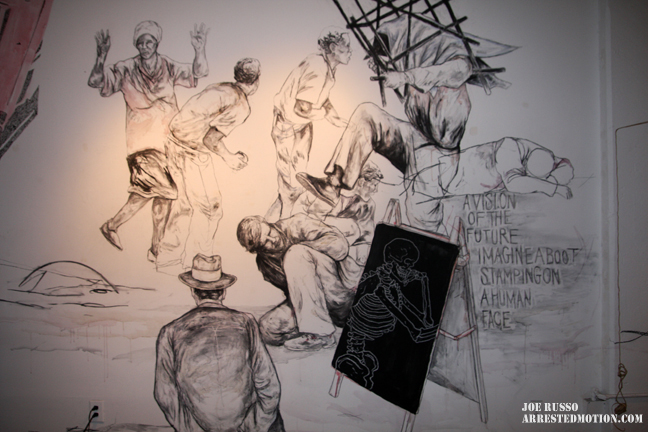
AM: What’s inspiring you at the moment?
AR: Today I ate breakfast with a very good friend of mine, and we talked about time and urgency and about insistence and ideals, and we talked in a way which made me want to turn that talk into action, to carry out to their full extend the things of which we spoke. And to keep on dreaming up new frontiers which to cross.
CS: I draw alot of inspiration from music of all kinds. It helps to extract my emotions on different subject matters which help guide me toward and within specific themes. For example I am currently working on a piece i will be producing in Norway at the NuArt festival. Norway is big in oil. I began thinking about oil and how it effects the world. I was listening to the Tom Waits song “Day after tomorrow” which tells the story of a soldier who becomes disillusioned and is looking forward to going home. War in my lifetime has mostly been over oil. So I included some imagery to coincide with those feelings.
AM: What’s worrying you at the moment?
AR: That I might one day not be able to talk in such a way as to inspire others to do more than just talk. That I might forget my curiosity for the words and the things that they can do.
CS: A few things… the income is not coming in. My wife is currently unemployed. I have a mortgage. 2 kids. I am constantly questioning my parenting techniques. Just want to make an effort ya know?
AM: Thanks for your time guys and good luck with the show. We are sad to hear that this will be the last show at Ad Hoc (more on this to follow). We wish Garrison and Allison all the best.
- Elbow Toe
- Luna Park & Veng
- Garrison of Ad Hoc & Armsrock
- Garrison & Allison Buxton, Armsrock, Chris Stain
- Swoon & Armsrock
- Armsrock
- Chris Stain
Exclusive photos by Joe Russo (AM-NY).
Discuss this show here.



